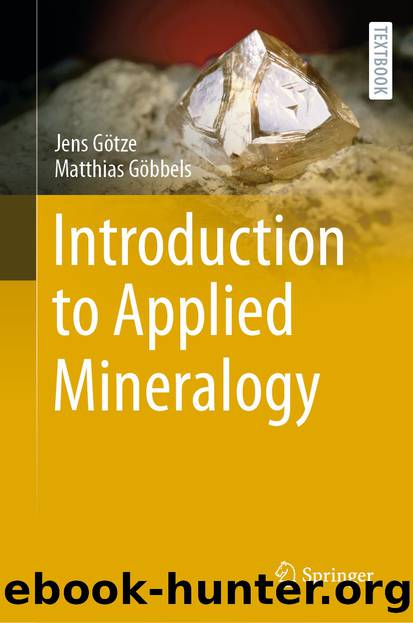Introduction to Applied Mineralogy by Jens Götze & Matthias Göbbels

Author:Jens Götze & Matthias Göbbels
Language: eng
Format: epub
ISBN: 9783662648674
Publisher: Springer Berlin Heidelberg
The curves show different behaviour: The fireclay brick (chamotte) expands up to approx. 1330 °C and then slowly begins to increasingly compress until it finally fails above 1500 °C. Fireclay bricks are made from clays. They are good, but not high quality materials. Due to impurities, including those caused by occupation between the layers, the raw material primarily introduces alkali/alkaline earth and, to a lesser extent, iron impurities, which lead to an initial low level of melting at approx. 1330 °C. This causes the grain bonding in the clay to become increasingly deformed. As a result, the grain bond in the microstructure is loosened and displaced by the load. With further temperature increase, the amount of melting and thus the displacement in the microstructure continue to increase until the stone shows no stability, regardless of the fact that it is only partially melted. The test curve of the sillimanite stone shows a comparable picture, the first melt formation and thus the compression do not start until about 1520 °C. The melting of the sillimanite stone is not very stable. Here iron is to be regarded as the main impurity which leads to this temperature of melt formation deviating from the phase diagram, while alkalis occur rather subordinately. Although this first melt is SiO2-rich and thus should actually be highly viscous, the iron content must still be taken into account. The iron in the melt makes it much less viscous and the drop in stability is then more dramatic. By way of anticipation, the silica stone should be discussed at this point. These stones are composed of SiO2 with small amounts of calcium for bonding. Alkalis and iron are also present here as minor impurities. The stone shows excellent stability up to 1660 °C, but as we are close to a congruent melting compound here, the increase in melt is quickly very high and the dramatic drop from 1690 °C shows complete melting.
On the basis of these test curves, statements can be made about the behaviour in the limit range. Irrespective of the temperature at which the first melt occurs, the silica stone fails very quickly, whereas sillimanite and fireclay stone can still absorb small amounts of melt forming in the structure and do not fail so dramatically quickly.
Fireclay bricks are used as lining in open fireplaces, wood stoves, rotary kilns in the lime and cement industries, in kilns for coarse and fine ceramic materials, etc.
Download
This site does not store any files on its server. We only index and link to content provided by other sites. Please contact the content providers to delete copyright contents if any and email us, we'll remove relevant links or contents immediately.
| Automotive | Engineering |
| Transportation |
Whiskies Galore by Ian Buxton(41938)
Introduction to Aircraft Design (Cambridge Aerospace Series) by John P. Fielding(33093)
Small Unmanned Fixed-wing Aircraft Design by Andrew J. Keane Andras Sobester James P. Scanlan & András Sóbester & James P. Scanlan(32764)
Craft Beer for the Homebrewer by Michael Agnew(18197)
Turbulence by E. J. Noyes(7978)
The Complete Stick Figure Physics Tutorials by Allen Sarah(7338)
Kaplan MCAT General Chemistry Review by Kaplan(6900)
The Thirst by Nesbo Jo(6879)
Bad Blood by John Carreyrou(6583)
Modelling of Convective Heat and Mass Transfer in Rotating Flows by Igor V. Shevchuk(6406)
Learning SQL by Alan Beaulieu(6237)
Weapons of Math Destruction by Cathy O'Neil(6215)
Man-made Catastrophes and Risk Information Concealment by Dmitry Chernov & Didier Sornette(5956)
Digital Minimalism by Cal Newport;(5704)
Life 3.0: Being Human in the Age of Artificial Intelligence by Tegmark Max(5516)
iGen by Jean M. Twenge(5385)
Secrets of Antigravity Propulsion: Tesla, UFOs, and Classified Aerospace Technology by Ph.D. Paul A. Laviolette(5333)
Design of Trajectory Optimization Approach for Space Maneuver Vehicle Skip Entry Problems by Runqi Chai & Al Savvaris & Antonios Tsourdos & Senchun Chai(5037)
Pale Blue Dot by Carl Sagan(4954)
